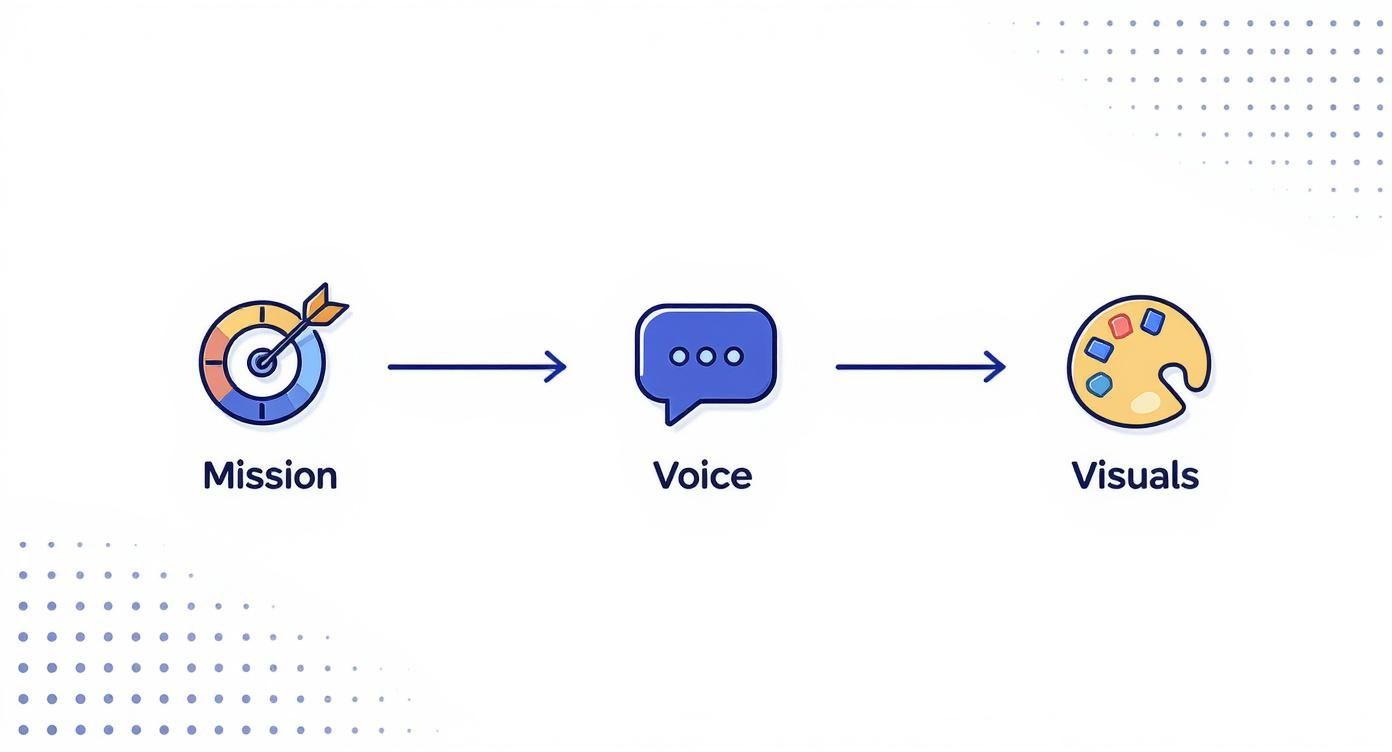
Understanding Ad Fatigue: Causes, Symptoms, and Solutions
Learn what is ad fatigue, its causes, symptoms, and effective solutions to combat it and keep your ad campaigns engaging and performing well.

If you want people to become aware of your brand, you first need a brand they can actually remember. This isn't just about a cool logo; it's about crafting a consistent, recognizable identity that shows up in everything you do—your mission, your voice, and your visuals. This foundation is what makes every interaction count.
Before you even think about tactics like social media campaigns or SEO, you have to get your brand's identity straight. Without it, you’re just shouting into the void. A strong identity is your strategic blueprint, guiding every marketing decision to create a seamless experience for your audience.
This initial work is all about defining who you are as a business. It’s like giving your brand a personality.
Getting these elements right is the critical first step. If you want to go deeper into figuring out who you're talking to, our guide on how to create buyer personas is a great place to start.
The process of building this foundation can feel abstract, so here’s a visual to map it out.

As you can see, a memorable brand begins with a clear mission, finds its unique voice, and then translates that identity into visuals that stick.
Nothing confuses customers more than inconsistent branding. Think about this: it takes an average of 5 to 7 impressions for someone to even begin to remember your brand.
When you nail that consistency, the results are powerful. Strong brand coherence can boost revenue by 10% to 20%. The surprising part? Only about 25% of companies actually enforce their brand guidelines properly. This creates a massive opportunity for anyone willing to put in the work.
For a great overview on this, check out this guide on how to build brand awareness from the ground up. It really drills down on how being consistent across every channel builds the trust and recognition you need to grow.
To make this tangible, let's break down the core components you need to define.
Building these elements isn't just a branding exercise; it's a business strategy. When you have this foundation, every piece of content you create works together to build something memorable.
If your brand's identity is the foundation, then great content is the engine that drives awareness. This isn't just about publishing random blog posts. It’s about building a system that consistently puts your brand in front of people who are actively searching for the very solutions you offer. It all starts with getting inside your audience's head.

The first step is always strategic keyword research. Forget about chasing high-volume, generic terms. Instead, zero in on the specific questions, pain points, and problems your ideal customers are typing into Google.
When you answer those questions directly through blog posts, videos, or in-depth guides, you instantly position yourself as a helpful expert, not just another company trying to make a sale.
"An effective brand resonates with consumers. It powers their purchasing decisions and reflects who they are and what they stand for."
That feeling of resonance is built one piece of genuinely helpful content at a time. The ultimate goal is to create assets that are so valuable people share them, and that search engines reward by showing them at the top of the results.
To move the needle on brand awareness, every piece of content needs to serve a clear purpose for the person on the other side of the screen. Think in terms of "content pillars"—those big, foundational topics that are core to your business.
From there, you can build out different types of content:
Every piece needs to be optimized for human beings first, and search engines second. And, of course, the platform you use to publish all this matters. Understanding the relationship between SEO and your CMS is key to making your workflow smooth and efficient.
When you consistently put out high-value content, you're creating countless new doorways for people to discover your brand. It’s a powerful, long-term strategy that builds the kind of trust and recognition that advertising alone can't buy.
Think of social media as less of a billboard and more of a block party. It's where you build a real tribe around your brand. If you want to boost your brand awareness, you have to stop broadcasting ads and start having actual conversations.
Show the people behind your brand. When someone comments, don't just "like" it—reply with a real thought. Kick off a poll to see what your audience thinks, or launch a campaign that puts your customers in the spotlight. Sharing user-generated content (UGC), like customer photos and stories, is one of the most authentic forms of social proof out there.

When you do this right, you turn passive followers into brand advocates. And that's a massive win for recognition, especially when you consider that over 5 billion people are on social media.
Building a community isn't about gathering followers. It’s about creating a space where people feel seen, heard, and connected to something bigger than just a product.
A common mistake brands make is trying to be everywhere at once. Spreading yourself thin on platforms where your ideal customers aren't active is a surefire way to waste resources. The goal is to be strategic. Go where your people are.
How do you choose? Think about your brand's personality and the content you're best at creating. A B2B software company will likely find a more receptive audience on a platform like LinkedIn, while a fashion brand will get more mileage from the visual-first worlds of Instagram and TikTok. Picking the right channels is the first step to making sure your community-building efforts actually land.
To help you narrow it down, here’s a look at how the major platforms stack up.
This table breaks down the main social channels to help you figure out where to focus your energy based on who you're trying to reach.
Ultimately, the best platform is the one where you can consistently show up and provide real value. Don't be afraid to experiment, but start with a focused approach based on where your customers are already spending their time.
Why go it alone when you can grow together? One of the smartest and fastest ways to get your brand in front of fresh eyes is through strategic partnerships. It’s all about tapping into new, relevant communities that another brand has already built.
Think of it as a shortcut to credibility. When a brand that people already know and trust introduces you to their audience, you gain instant visibility and a stamp of approval.
The trick is finding the right fit. You’re not looking for direct competitors, but complementary businesses whose offerings make sense alongside yours. A local coffee roaster teaming up with a popular bakery is a classic example. Or a fitness app collaborating with a sustainable activewear brand—it just works.
When a partnership feels natural and offers real value to both audiences, everyone wins. The collaboration makes perfect sense to customers, making the awareness you build more authentic and likely to stick.
This isn't just about getting more eyeballs; it’s about getting in front of the right eyeballs. You get direct access to a pre-qualified audience that’s probably going to be interested in what you have to say. It’s a powerful way to amplify your message far beyond your own reach.
First, identify potential partners. Look for brands that share your core values and speak to a similar customer demographic, but aren't selling the exact same thing. The goal is to find that sweet spot of audience overlap without stepping on anyone's toes.
Once you’ve got a shortlist, it's time to reach out with a solid pitch. Don't just send a generic email asking for a shout-out. Propose a specific, mutually beneficial idea.
Here are a few proven ways to collaborate:
Whatever you decide, make sure the value proposition is clear for both sides. When you pool your resources and share your audiences, you’re not just building awareness—you're creating a powerful engine for mutual growth.
It’s easy to get caught up in chasing massive, global reach, but don't forget where powerful brand loyalty is often forged: in your own backyard or within a tight-knit community. Tapping into these smaller, more focused groups can create a loyal following that a broader strategy might overlook.
People are naturally drawn to brands that get them. Whether that’s understanding local culture, shared values, or a very specific hobby, that connection matters. For an online business, this might mean building a community around a shared passion. If you have a physical presence, it’s about weaving your brand into the fabric of the neighborhood.
Zeroing in on local and niche audiences is a smart business play. The data backs this up. A recent study found that 47% of people worldwide feel it's important to support locally owned companies.
This sentiment is particularly strong in certain areas. For example, 36% of North Americans are actively looking for ways to support local businesses. You can explore these findings by checking out the latest global consumer trends on mckinsey.com.
So, how can you put this into practice?
Building a brand in a niche community is like becoming a big fish in a small pond. You can achieve a level of trust and authority that's nearly impossible to replicate on a global scale.
Connecting with these specific groups builds incredible trust and gives you a real competitive edge. It's how you go from being just another name to becoming a brand that people truly care about.
Launching campaigns to boost brand awareness is a great first step, but how do you know if you're making a dent? If you're not tracking anything, you're just guessing. Real measurement is about connecting your marketing activities to actual data, so you can see what's working and what's not.
It boils down to tracking the right Key Performance Indicators (KPIs). I'm not talking about vanity metrics. I mean the signals that directly show your brand's footprint is expanding. The key is to focus on a handful of metrics that tell a clear story.
The best way to gauge progress is to look at a blend of direct and indirect signals. Direct traffic, for instance, is a huge one—it tells you how many people are typing your website URL straight into their browser. That’s a powerful sign of strong brand recall.
Here are the essential KPIs to keep a close eye on:
The point of measuring isn't just to have a bunch of numbers on a dashboard. It’s about finding the story in the data. Did you see a big jump in direct traffic after an influencer campaign went live? That tells you the partnership is driving real recognition.
These metrics will give you a solid foundation. If you want to dive deeper and connect these activities to the bottom line, our guide on how to measure marketing ROI breaks down how to calculate the financial impact of your campaigns.
Tracking these numbers consistently is what separates guessing from strategy. It empowers you to prove your value and make smarter decisions that keep your brand on an upward trajectory.
At BrandBooster.ai, we focus on outcome-driven marketing that delivers results you can actually see. We blend expert strategy with AI-powered insights to build brand awareness that translates directly into business growth. Learn more at https://www.brandbooster.ai.